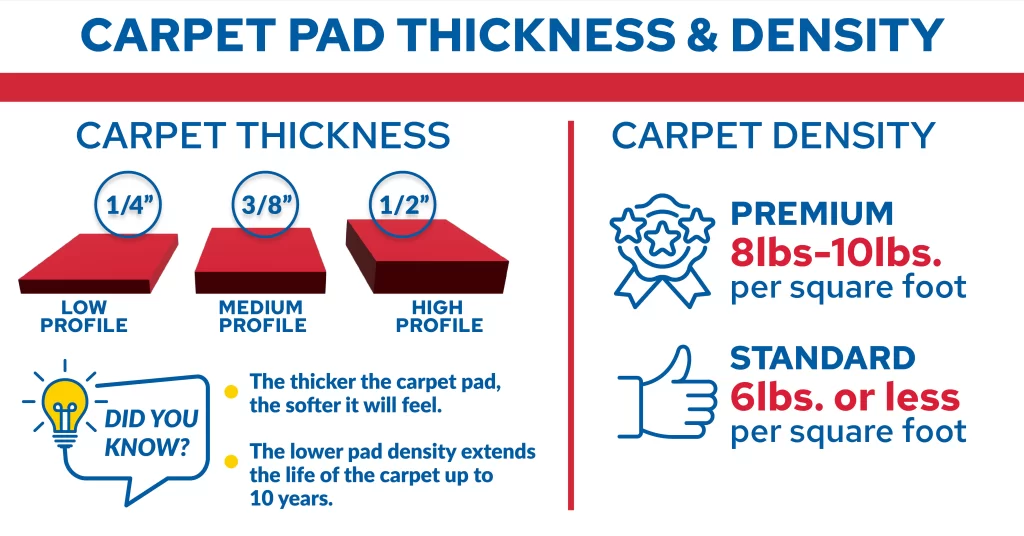That thin piece of your flooring, the carpet padding, plays a major role in the life of your carpet. But who thinks much about it? If you inherited the padding when you bought your home, and if you’ve never spilled any liquid on your carpet, you have little to ponder until it’s time to replace the carpet. But if you’re shopping for new carpet, had a spill or your pet had an accident, here’s what you need to know about the humble carpet pad.
Types of Padding
Bonded Urethane
The most popular residential carpet padding consists of bonded urethane, or rebond. Manufacturing rebond may have been the first large-scale, useful recycling industry. Comprised of scrap urethane foam from the furniture and upholstery industries, the makers of bonded urethane collect new scraps and old from all over the world. Then, they chip it all up into small pieces and either heat-meld the chunks or bond them together with adhesives. From there, they apply a film, netting or fabric finish to hold it all together. While you can find very high-quality, dense rebond, it’s still the most economical of all types of carpet padding.

Urethane Foam
Alternatively, new urethane foam padding is formed new rather than from compacted recycled bits thereof. Whether fresh foam or recycled, manufacturers offer a large range of qualities, some with waterproof finishes.
Rubber
Rubber padding can be made as a single mat, from foamed or frothed rubber or textured in a waffle pattern for economy. Rubber makes for top-quality padding and is most often used in commercial installations.
Fiber
Originally, fiber padding was made from animal hair cast-off from the tanning industry. Now, it is often composed of jute or other plant fibers. Some synthetic fibers get recycled into carpet padding, too. With its strong constitution, it serves almost as well as rubber in high-traffic commercial buildings.
Rubber and fiber padding costs quite a bit more than urethane and may be more difficult to acquire for residential use, but they’ll help your carpet hold up longer.

Choosing the Right Padding for Your Needs
The Impact of Padding on Carpet Comfort
Additional Benefits of Carpet Padding
What’s the Point of Padding?
A popular myth about carpet pads suggests that its use is to add comfort. In reality, however, padding prevents the carpet from sliding and stretching when you walk on it. This movement wears the carpet quickly unless you can remediate it. Contrary to popular belief, your carpet will hate a thick pad because it will shift, stretch and deform under footfall. Contrary, it will love a thin, dense pad that grips it tight.
Padding Can and Should Be Cleaned
When spills penetrate the carpet before you can blot them up, they can soak into the padding and prevent a full cleaning of the stain. You should never allow pet accidents, with their unpleasant odors, to remain in the padding once you’ve cleaned it from above. Here’s how you can clean your carpet padding.
Mix four parts water with one part white vinegar. Pull the carpet up from its tacks at the nearest corner to expose the stain. Pour the water/vinegar solution over the stain and let it sit for about half an hour. Scrub gently, then blot as much as possible. Now pour clean rinse water over the spot and blot it well. Allow it to dry thoroughly. You can use a fan to help speed the drying. Then replace the carpet and secure it to the tacks.
If you’re worried you won’t be able to completely remove the stain and odor of a pet accident, be sure to contact Chet’s Cleaning. We remove pet stains and odors efficiently, so they don’t come back to haunt you. With our exceptional carpet cleaning service and pet odor removal guarantee, you can restore your carpet and padding to breathe easy again!
FAQs
How Do I Know What Thickness of Padding I Need For My Carpet?
The thickness of padding needed for your carpet depends on the type of carpet you have and your personal preference for cushioning. Generally, a padding thickness of 7/16 inch is recommended for most residential carpets. However, it’s best to consult with a flooring professional or refer to the carpet manufacturer’s guidelines.
Can I Use the Same Padding for Different Types of Carpet?
No, different types of carpet require different types of padding to ensure optimal performance and longevity. For example, Berber carpet requires a denser, thinner padding than plush carpet. Be sure to choose a padding that is specifically designed for your carpet type.
How Do I Know When It Is Time to Replace My Padding?
Padding typically lasts as long as the carpet itself, but there are some signs that it may be time to replace it. These include visible signs of wear and tear, such as rips or tears, as well as a decrease in cushioning or an increase in matting. If you’re replacing your carpet, it’s generally recommended to replace the padding at the same time.
Is It Okay to Use Multiple Layers of Padding for Extra Cushioning?
No, using multiple layers of padding can actually cause more harm than good. It can lead to stretching, wrinkling, and overall damage to the carpet, as well as voiding the manufacturer’s warranty. Stick to a single layer of padding that is designed for your specific carpet type.
